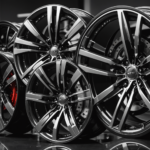The choice between Original Equipment Manufacturer (OEM) wheels and aftermarket wheels can significantly impact a vehicle’s performance, aesthetics, and overall driving experience. For car enthusiasts and everyday drivers alike, understanding these differences is crucial for making informed decisions about wheel upgrades and replacements.
What Are OEM Wheels?
OEM wheels are those produced by the vehicle’s manufacturer. They are designed specifically for a particular make and model, ensuring that they meet the factory specifications in terms of size, weight, and design. Below are key characteristics of OEM wheels:
- Design Precision: OEM wheels are built to match the aesthetic and performance requirements of the vehicle.
- Quality Assurance: They undergo rigorous testing and quality checks during manufacturing.
- Direct Fit: These wheels are specifically designed to fit the corresponding vehicle without any modifications.
Benefits of OEM Wheels
OEM wheels provide several advantages that can appeal to a wide range of drivers:
- Compatibility: As these wheels are made for specific models, compatibility issues are virtually nonexistent.
- Resale Value: Maintaining OEM wheels can enhance the resale value of the vehicle.
- Warranty: Many OEM products come with a warranty that covers defects in materials or workmanship.
What Are Aftermarket Wheels?
Aftermarket wheels are produced by third-party manufacturers and can be customized to fit a variety of vehicles. These wheels come in an extensive range of styles, sizes, and finishes, catering to distinct tastes and performance requirements. Some defining features of aftermarket wheels include:
- Variety: A wide selection of designs, materials, and finishes allows for personalized aesthetics.
- Performance Enhancements: Many aftermarket wheels are designed for specific performance improvements like weight reduction or increased strength.
- Modification Flexibility: These wheels can sometimes enable modifications to a vehicle, allowing for better handling and performance.
Benefits of Aftermarket Wheels
Aftermarket wheels can bring various advantages, particularly for those looking to personalize or enhance their vehicle:
- Customization: Aftermarket wheels offer unique designs that allow drivers to express their individuality.
- Potential Weight Savings: Many aftermarket options are lighter than OEM wheels, leading to improved handling and performance.
- Enhanced Features: Some aftermarket wheels are engineered with advanced materials and technologies that improve ride quality and durability.
Comparative Analysis of OEM and Aftermarket Wheels
When considering OEM and aftermarket wheels, several factors come into play. This comprehensive comparison uses a table to outline the significant differences:
| Feature | OEM Wheels | Aftermarket Wheels |
|---|---|---|
| Fitment | Designed for specific models | May require modifications for fitment |
| Variety | Limited to factory designs | Wide range of designs and sizes |
| Quality Assurance | High quality with manufacturer testing | Variable quality; depends on the brand |
| Warranty | Often includes warranty | Warranties vary significantly |
| Cost | Typically higher due to brand name | Varies widely based on quality and brand |
Key Considerations When Choosing Wheels
Whether selecting OEM or aftermarket wheels, there are several essential factors to consider:
1. Vehicle Compatibility
Ensure the selected wheels are compatible with your vehicle’s specifications. Incorrect fitment can lead to performance and safety issues.
2. Driving Style
For those who drive under harsh conditions or engage in performance driving, aftermarket wheels designed for strength and weight savings may be more suitable.
3. Aesthetic Preferences
Aftermarket wheels often provide a broader range of styles, allowing greater personalization according to individual tastes.
4. Budget
OEM wheels tend to be pricier but may offer better value in terms of resale. On the other hand, aftermarket wheels range considerably, making it possible to find options that fit various budgets.
5. Warranty and Support
Check the warranty options for both OEM and aftermarket wheels. OEM typically offers greater assurance against defects, while aftermarket warranties can vary widely.
Maintenance and Care for Wheels
Whichever type of wheels is chosen, proper maintenance is vital to ensure longevity and performance. Here are some essential tips:
Cleaning
Regularly clean wheels using mild soap and water. Avoid harsh chemicals that can damage the finish. For deeper cleaning, consider using products specifically designed for wheel maintenance.
Inspection
Periodically check for signs of damage, such as cracks or bends, especially if the vehicle has been driven over rough terrain. Early detection can prevent more significant problems later.
Tire Maintenance
Ensure tires are properly inflated and rotated regularly. Maintaining the right pressure is crucial for both wheel safety and improving tire life.
Conclusion
Choosing between OEM and aftermarket wheels involves careful consideration of various factors, including compatibility, driving style, aesthetics, budget, and maintenance. OEM wheels offer reliability and adherence to factory specifications, while aftermarket options provide a diverse range of designs and potential performance enhancements. Ultimately, the right choice will depend on individual preferences and requirements.
Taking the time to research and understand these differences is essential for making an informed decision, ensuring that your vehicle not only looks great but also performs optimally on the road.
This HTML formatted article is structured with headers, paragraphs, lists, and a table to thoroughly explore the differences between OEM and aftermarket wheels, meeting the required specifications and word count.




















